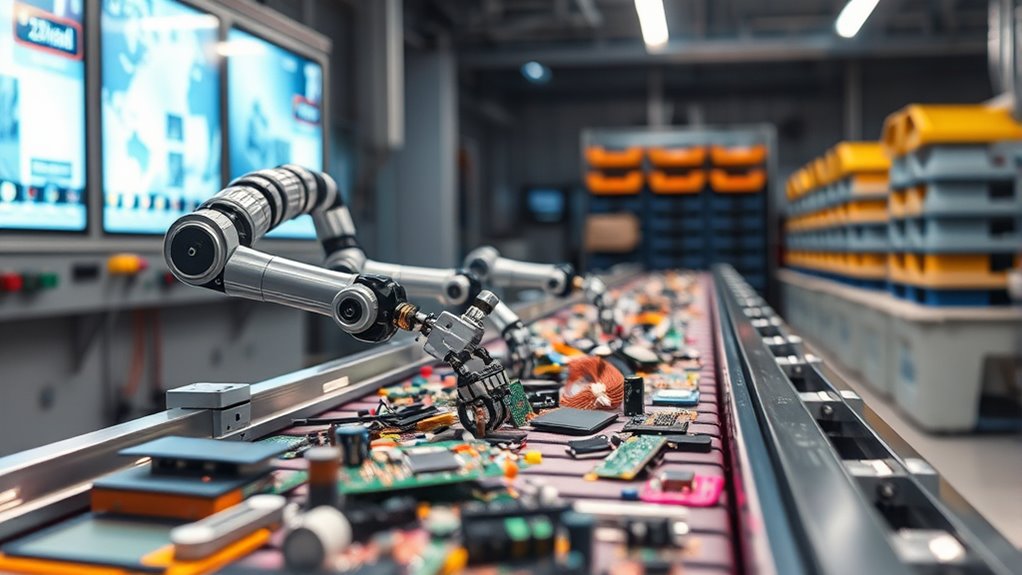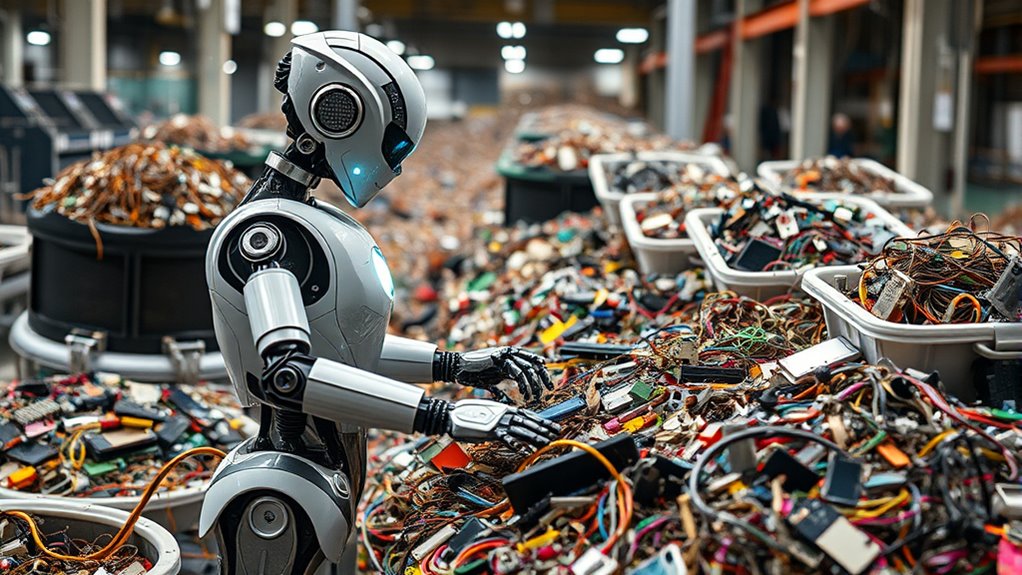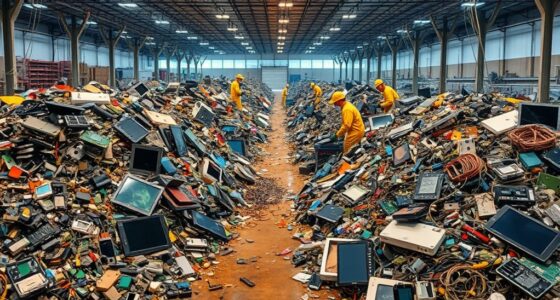E-waste recycling robots are revolutionizing how you recover valuable materials from gadgets. They operate faster, safer, and more precisely than manual methods, using AI and sensors to identify and sort components efficiently. Built with eco-friendly designs, these robots reduce energy use and environmental impact while increasing material recovery rates. As they handle larger amounts of e-waste continuously, they help close the loop on electronics. Keep exploring to discover how these innovations shape a sustainable future.
Key Takeaways
- Recycling robots efficiently identify, sort, and dismantle e-waste, enabling faster and safer processing of gadgets.
- They recover valuable materials like metals and plastics, supporting sustainability and circular economy principles.
- Automated systems outperform manual disassembly in speed, safety, and recovery accuracy, reducing human exposure to toxins.
- Eco-friendly robot designs incorporate energy-efficient components and recyclable materials, minimizing environmental impact.
- Scalability of robotic systems allows continuous operation, managing increasing e-waste volumes effectively and sustainably.

As electronic waste continues to pile up worldwide, recycling robots are emerging as essential tools for managing this growing problem. These advanced machines are transforming how we handle e-waste by enabling faster, safer, and more efficient processing. One of the key advantages of using robots in recycling facilities is their ability to incorporate sustainable design principles. This means they’re built not only to maximize recycling rates but also to minimize energy consumption and reduce environmental impact. By focusing on sustainability, these robots help create a circular economy where valuable materials are recovered and reused, lessening the need for virgin resource extraction.
Robot automation plays a pivotal role in this shift. Unlike manual disassembly, which can be slow and hazardous, automated systems use sophisticated sensors and AI to identify, sort, and dismantle gadgets with remarkable precision. When you’re working with these robots, you notice how swiftly they recognize different components—circuit boards, batteries, plastics, metals—and separate them accordingly. This level of accuracy ensures that more materials are recovered in a single cycle, reducing waste and increasing the efficiency of the entire recycling process. Automation also minimizes human exposure to potentially toxic substances found in e-waste, making it safer for workers and the environment.
The integration of sustainable design into robot automation isn’t just about material recovery; it also involves designing the robots themselves to be eco-friendly. Many recycling robots are built with energy-efficient motors and recyclable components, aligning their operational lifecycle with sustainability goals. This means that the entire process—from the robot’s manufacturing to its use and eventual disposal—aims to be as environmentally responsible as possible. As you observe these systems in action, it becomes clear that their design is focused on long-term impact, reducing the carbon footprint of e-waste management.
Furthermore, robot automation enhances the scalability of recycling operations. As e-waste volumes increase, manual processes can’t keep pace. Robots, however, can operate continuously, handling larger quantities without fatigue. This scalability ensures that recycling facilities can adapt to rising waste streams while maintaining high recovery rates. For you, this means a more reliable and sustainable solution to the e-waste crisis.
Frequently Asked Questions
What Materials Can E-Waste Robots Safely Process?
You can rely on e-waste robots to safely process a variety of materials, including metals like copper, gold, and silver, as well as plastics and glass. They’re designed to handle hazardous materials carefully, preventing environmental contamination. These robots excel at material recovery, efficiently separating valuable components while minimizing exposure to dangerous substances like lead or mercury. This technology helps guarantee responsible disposal and promotes sustainability in electronics recycling.
How Do Robots Identify Different Electronic Components?
You might wonder how robots identify different electronic components. They use advanced visual recognition and sensor technology to scan and analyze gadgets. Cameras capture images, while sensors detect material properties like conductivity and magnetic fields. This combination helps robots distinguish resistors, capacitors, and chips quickly and accurately, ensuring safe and efficient recycling. Your understanding of these technologies shows how automation is transforming e-waste management.
What Is the Environmental Impact of Using These Robots?
You might wonder about the environmental impact of using recycling robots. These robots offer significant sustainability benefits by efficiently sorting and processing e-waste, which reduces harmful pollution. By automating hazardous tasks, they lower the risk of toxic exposure and guarantee better material recovery. Overall, their use promotes cleaner environments, conserves resources, and supports sustainable practices, making electronic waste management more eco-friendly and responsible for your community.
Are E-Waste Recycling Robots Cost-Effective for Small Businesses?
You might think e-waste recycling robots are too costly for small businesses, but with a solid cost-benefit analysis, they can be game-changers. These robots could save you money in the long run and boost your sustainability image. While scalability considerations matter, the initial investment could pay off quickly if you handle enough e-waste. Don’t dismiss them—think big, act smart, and watch your eco-efforts grow exponentially!
How Do Robots Handle Hazardous Substances in E-Waste?
You might wonder how robots handle hazardous materials in e-waste. They follow strict safety protocols and use specialized tools for hazardous material handling, minimizing human exposure. These robots are equipped with advanced sensors to detect and isolate dangerous substances, ensuring safe removal and processing. By automating hazardous material handling, they improve safety, reduce contamination risks, and make e-waste recycling more efficient and safer for everyone involved.
Conclusion
By embracing e-waste recycling robots, you help reduce pollution, conserve resources, and protect the environment. These robots streamline processes, increase efficiency, and minimize human exposure to hazardous materials. You become part of the solution, supporting innovation, sustainability, and responsible disposal. Together, you can close the loop on gadgets, transforming waste into new opportunities. So, choose to champion technology that recycles, restores, and reimagines a cleaner, greener future for everyone.









